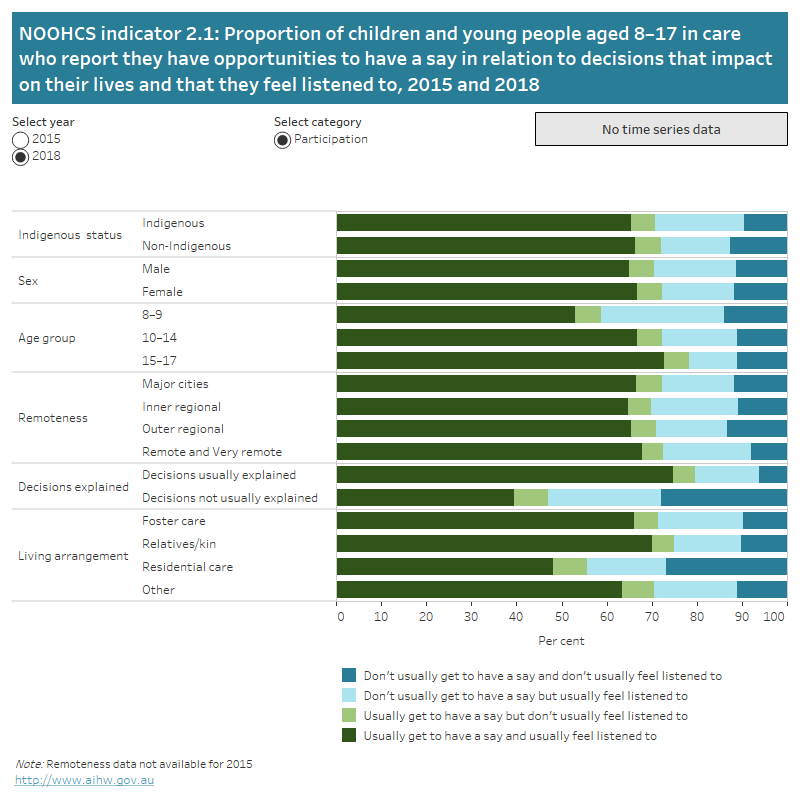2.1 Participation
Children may be in care due to abuse or neglect, or because their family is unable to care for them (for example, due to illness or incarceration). It is important that children in care have the opportunity to participate in decision-making about their lives.
This indicator uses results from a national survey of children in care; those whose care arrangements have been ordered through the Children’s Court, where parental responsibility for the child or young person has been transferred to the Minister/Chief Executive.
Children were asked about whether they feel they get to have a say in what happens to them, and whether they feel listened to. As an additional explanatory factor, children were also asked whether someone explains the decisions made about them.
Trend data: For all indicator displays, the yearly trend is limited to indicators with 3 or more years (including the current year) of comparable time series data. To see the trend click on “Yearly Trend” button on the display. Where 3 or more years of comparable data including the most recent year is not available, a “No time series data” message is shown on the display.
The horizontal stacked bar graph shows the proportion of children and young people aged 8–17 in care who report they have opportunities to have a say in relation to decisions that have an impact on their lives and that they feel listened to, by sex, age group, remoteness, decisions explained and living arrangement. Each bar includes proportions regarding the extent of participation. Data can be selected by year from 2015 or 2018.

Source: AIHW Out-of-home care survey national dataset 2015 and 2018
See the supplementary data tables for further information and footnotes about these data.
Indicator technical specifications
The information below provides technical specifications for the summary indicator data presented in the quick reference guide.
| Definition | Data source | |
|---|---|---|
| Numerator | Number of children aged 8-17 years in care who report they usually get to have a say in what happens to them and people usually listen to what they say | AIHW Out-of-home care survey national dataset |
| Denominator | Number of responding children aged 8-17 years in the reference period | AIHW Out-of-home care survey national dataset |
Explanatory notes
Data are sourced from a national survey of children in care. Further interpretive information for the indicators, and background information on the survey, is provided in the AIHW report The views of children and young people in out-of-home care: overview of indicator results from second national survey, 2018.
Children ‘in care’ are those who were residing in out-of-home care (including foster care, relative/kinship care, family group homes, residential care and independent living), whose care arrangements had been ordered by the relevant Children’s Court and where the parental responsibility for the child had been transferred to the Minister or Chief Executive, and who had been on a relevant court order for three months or more. Please note that the titles of the relevant ‘Children’s Courts’ may vary across states/territories.
Children aged 8–17 years were asked three questions: ‘Do you get to have a say in what happens to you, such as where you live, your school and learning, and your future?’, ‘Do people listen to what you say?’ and ‘Do people explain the decisions made about you?’ Each question had four response categories: ‘All the time’, ‘Most of the time’, ‘Not very often’, and ‘Never’.
The numerator includes children who reported ‘All the time’ or ‘Most of the time’ to both questions.
The numerator and denominator exclude children with a ‘not stated’ response for one or both questions.


